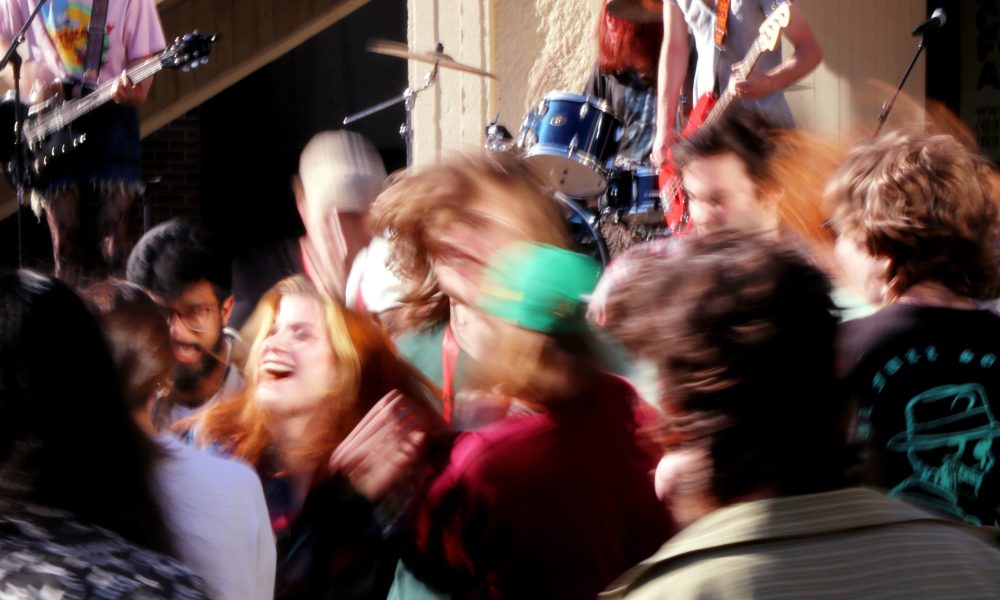Above: Photo by Nasser Halaweh/Wikimedia Commons
While I prepared to go underwater, Gabriel Costa, one of the instructors guiding my family on a scuba diving vacation, showed me the hand sign used by scuba divers all over the world to communicate that a lionfish is on site. The gesture is made by intertwining the fingers of both hands to resemble the lionfish’s poisonous spines, which are rarely lethal but can cause extreme pain and other symptoms in humans.

My first encounter with the carnivorous fish came as a surprise three years ago during a scuba diving trip to the island of Roatán off the coast of Honduras. The only other time I saw the species was last year in the waters around Fernando de Noronha, which was also unexpected. Returning to the Brazilian island this June, I knew the chances of seeing it again were higher than in 2021.
Native to the Indo-Pacific, the lionfish is an invasive species in the Atlantic. Although the exact cause of its invasion is unknown to scientists, they believe it involves human interference. According to the National Ocean Service, some scientists speculate that people have been dumping fishes from home aquariums into the ocean for a long time. The first lionfish reported in the Atlantic was found in Florida in 1985, and the species was documented as “established” — meaning that it had created a self-sustained population — in the early 2000s. Since then, it has spread south, crossing the entire Caribbean and arriving at the Brazilian coast in a region near the mouth of the Amazon River. In December 2020, the appearance of the lionfish at Fernando de Noronha, an island one hour by plane off the northeastern coast of Brazil, proved its expansion.
Due to the species’ lack of predators in the Atlantic and its fast reproduction rate, its population is growing at higher rates than what the environment can support. Scientists fear that an abundant community of lionfish in Fernando de Noronha might consume the island’s resources faster than they are naturally replaced.
No more than five minutes after the start of the dive, I saw Costa emerge from behind the coral reefs, making the lionfish sign with his hands. I followed him to the place where he had discovered it, at about 50 meters under the surface.
The fish was paradoxical; it evoked real and fantastical images at the same time. Its tail reminded me of a broom, a mundane object, yet its fins resembled wings made of petals, something imaginary. For a while, I could only focus on the spines on its back and how the signal that Costa made with his hands did, in fact, resemble them. The thought that such a majestic creature could become so destructive in the wrong habitat felt heartbreaking and somehow unfair.
“It is one of the biggest I’ve ever seen,” Costa said as soon as we raised our heads above the water.
He has worked as a scuba diving instructor on the island since 2002. The first time he saw a lionfish was in September 2021.
“It was very little,” he said about that first sighting. “It wasn’t larger than a stretched thumb.”
Between then and now, Costa has seen the fish five times. He said when it happens, his fellow instructors work with him to catch it if possible. They share information about their encounters with ICMBio, the Brazilian Ministry of the Environment’s administrative arm.
“We always communicate with ICMBio, when we catch it and when we don’t. When we do catch it, we deliver the specimen to them.”

Costa said that in the beginning of the year, every person who works on the island’s scuba diving operations team received training on how to use a Hawaiian harpoon to kill, capture and store the fish correctly, avoiding their poisonous spines. He said the first capture he was involved in was upsetting.
“Although this is the recommendation, I don’t like killing animals,” he said. “I hope the lionfish can come into harmony with the ecosystem of Noronha.”
Clara Buck, a marine biology researcher who works with lionfish handling in Fernando de Noronha in partnership with ICMBio, said she expects the fish to completely establish itself off the coast of Brazil. She is working with the organization to construct an action plan to control the population based on different phases of invasion. It would be very difficult to eradicate the species from the island — such a task would entail eliminating all of the lionfish in the Atlantic, which is an impossible feat due to how adaptable of a species it is.
“The lionfish can survive up to 300 meters deep in waters with different pHs and visibility,” Buck said. “It eats everything and is able to deal with environments very different from the ones it is used to. It also reproduces very well. It can lay 30,000 eggs a month and its reproduction lasts the entire year.”

Buck emphasized that the first step in the process of handling an invasive species is educating the local population with banners, flyers and classes.
“There, in the Amazon river’s mouth, the fishers didn’t know [what they were fishing],” she said. “They thought, ‘What a weird fish!’ and returned it to the water.”
Additionally, she said that authorities can begin informing the public before the invasion begins. When the lionfish appeared in other South American countries like Venezuela and Guyana in 2013, Brazilian scientists were alarmed at the possibility of its appearance in Brazil. In 2016, a researcher named Pedro Pereira went to Fernando de Noronha and warned the locals about this threat. At the time, Buck said, some called him an alarmist. However, she emphasized that this process is fundamental for any situation involving an invasive species.
“The scientific dissemination is the first part in a project of invasive species handling,” she explained. “The people need to know the species and this is something we do up to this day.”
After starting to educate the local population, Buck and her team promoted a training program for dive operators, in which Costa participated. To teach the instructors to capture lionfish, they enlisted biologist Paulo Bertoul, who has been working with the species for more than 10 years on the island of Bonaire off the coast of Venezuela.

“There was one theory class for everyone, and then a practical class for separate groups of people,” Buck said. “It took us seven days until we were able to do it with all the divers of all operations.”
Beyond giving the training, they had to gain a legal authorization to use harpoons, since underwater fishing is prohibited on the island.
With education, training and authorization properly done, the plan is to manually remove lionfish from the ocean. So far, divers in Noronha have collected more than 50.
Once a lionfish is captured and delivered to ICMBio, Buck asks the diver for basic information about the fish, including how deep underwater it was, the kind of environment it was in and its behavior at the time of the capture. Then Buck takes basic biometric data, including the fish’s size and weight, and collects a sample of the fish’s gills. This data and sample is sent to different scientists around the world who study the genetics and biology of the lionfish, aiming to understand how its population on the island is developing.
However, all of these mitigation efforts hinge on the fact that the lionfish’s invasion of the island is in its initial stage. Although it is not clear how long it might take for the lionfish to establish itself on the island, Buck explained that she expects this to happen. When it does, they will have to somehow introduce the lionfish in commerce.
“In Bonaire, they are doing this kind of control: supporting captures and doing competitions,” she said. “Several times a year, there are groups of fishers that gather together to award who got the biggest, the greatest amount, the smallest, the prettiest, the ugliest. … They are transforming the lionfish into a valuable asset that moves the economy.”
There are limitations to these solutions, though. Buck said one of them is that physically taking the fish out of the water takes time and effort, making it too slow a process to effectively decrease the population. Another one is the mental toll involved in killing animals, which Costa cited.
“There is an ethics question behind all of it,” Buck said. “It’s a fight that has to be done because human beings caused this somehow, and we need to fix the damage we’ve done.” As some people might say in a popular Brazilian expression, há males que vem para o bem — there are evils that come with the good.




Comments are closed.